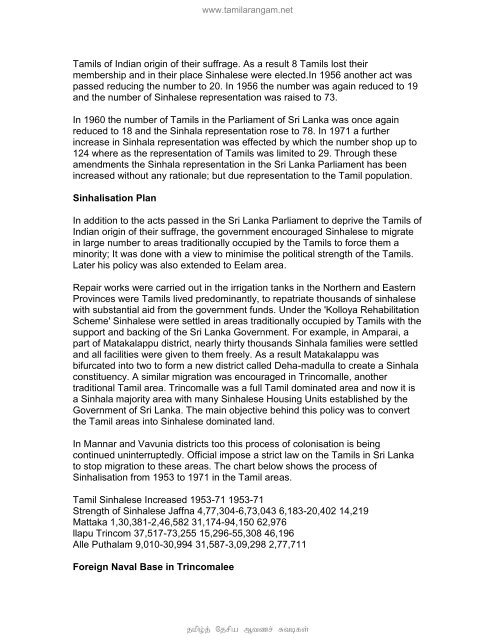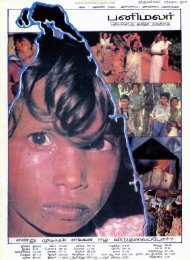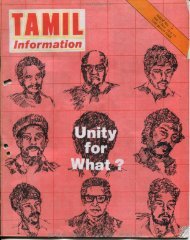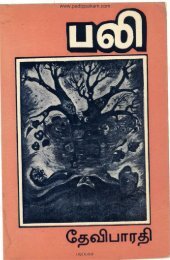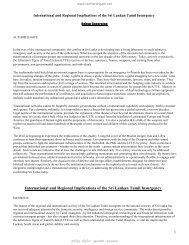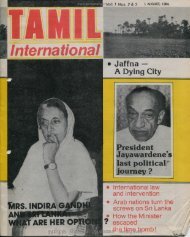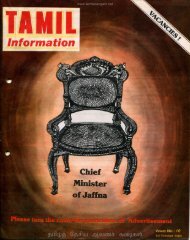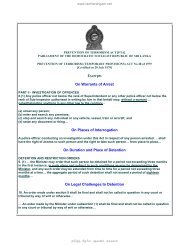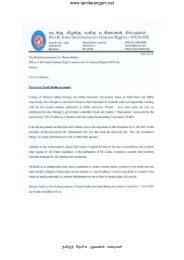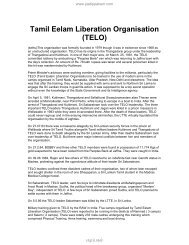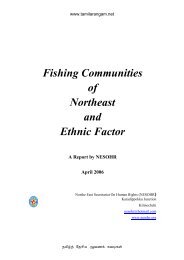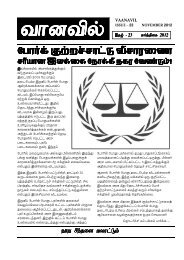Genesis of Ethnic Strife in Sri Lanka
Genesis of Ethnic Strife in Sri Lanka
Genesis of Ethnic Strife in Sri Lanka
You also want an ePaper? Increase the reach of your titles
YUMPU automatically turns print PDFs into web optimized ePapers that Google loves.
Tamils <strong>of</strong> Indian orig<strong>in</strong> <strong>of</strong> their suffrage. As a result 8 Tamils lost their<br />
membership and <strong>in</strong> their place S<strong>in</strong>halese were elected.In 1956 another act was<br />
passed reduc<strong>in</strong>g the number to 20. In 1956 the number was aga<strong>in</strong> reduced to 19<br />
and the number <strong>of</strong> S<strong>in</strong>halese representation was raised to 73.<br />
In 1960 the number <strong>of</strong> Tamils <strong>in</strong> the Parliament <strong>of</strong> <strong>Sri</strong> <strong>Lanka</strong> was once aga<strong>in</strong><br />
reduced to 18 and the S<strong>in</strong>hala representation rose to 78. In 1971 a further<br />
<strong>in</strong>crease <strong>in</strong> S<strong>in</strong>hala representation was effected by which the number shop up to<br />
124 where as the representation <strong>of</strong> Tamils was limited to 29. Through these<br />
amendments the S<strong>in</strong>hala representation <strong>in</strong> the <strong>Sri</strong> <strong>Lanka</strong> Parliament has been<br />
<strong>in</strong>creased without any rationale; but due representation to the Tamil population.<br />
S<strong>in</strong>halisation Plan<br />
In addition to the acts passed <strong>in</strong> the <strong>Sri</strong> <strong>Lanka</strong> Parliament to deprive the Tamils <strong>of</strong><br />
Indian orig<strong>in</strong> <strong>of</strong> their suffrage, the government encouraged S<strong>in</strong>halese to migrate<br />
<strong>in</strong> large number to areas traditionally occupied by the Tamils to force them a<br />
m<strong>in</strong>ority; It was done with a view to m<strong>in</strong>imise the political strength <strong>of</strong> the Tamils.<br />
Later his policy was also extended to Eelam area.<br />
Repair works were carried out <strong>in</strong> the irrigation tanks <strong>in</strong> the Northern and Eastern<br />
Prov<strong>in</strong>ces were Tamils lived predom<strong>in</strong>antly, to repatriate thousands <strong>of</strong> s<strong>in</strong>halese<br />
with substantial aid from the government funds. Under the 'Kolloya Rehabilitation<br />
Scheme' S<strong>in</strong>halese were settled <strong>in</strong> areas traditionally occupied by Tamils with the<br />
support and back<strong>in</strong>g <strong>of</strong> the <strong>Sri</strong> <strong>Lanka</strong> Government. For example, <strong>in</strong> Amparai, a<br />
part <strong>of</strong> Matakalappu district, nearly thirty thousands S<strong>in</strong>hala families were settled<br />
and all facilities were given to them freely. As a result Matakalappu was<br />
bifurcated <strong>in</strong>to two to form a new district called Deha-madulla to create a S<strong>in</strong>hala<br />
constituency. A similar migration was encouraged <strong>in</strong> Tr<strong>in</strong>comalle, another<br />
traditional Tamil area. Tr<strong>in</strong>comalle was a full Tamil dom<strong>in</strong>ated area and now it is<br />
a S<strong>in</strong>hala majority area with many S<strong>in</strong>halese Hous<strong>in</strong>g Units established by the<br />
Government <strong>of</strong> <strong>Sri</strong> <strong>Lanka</strong>. The ma<strong>in</strong> objective beh<strong>in</strong>d this policy was to convert<br />
the Tamil areas <strong>in</strong>to S<strong>in</strong>halese dom<strong>in</strong>ated land.<br />
In Mannar and Vavunia districts too this process <strong>of</strong> colonisation is be<strong>in</strong>g<br />
cont<strong>in</strong>ued un<strong>in</strong>terruptedly. Official impose a strict law on the Tamils <strong>in</strong> <strong>Sri</strong> <strong>Lanka</strong><br />
to stop migration to these areas. The chart below shows the process <strong>of</strong><br />
S<strong>in</strong>halisation from 1953 to 1971 <strong>in</strong> the Tamil areas.<br />
Tamil S<strong>in</strong>halese Increased 1953-71 1953-71<br />
Strength <strong>of</strong> S<strong>in</strong>halese Jaffna 4,77,304-6,73,043 6,183-20,402 14,219<br />
Mattaka 1,30,381-2,46,582 31,174-94,150 62,976<br />
llapu Tr<strong>in</strong>com 37,517-73,255 15,296-55,308 46,196<br />
Alle Puthalam 9,010-30,994 31,587-3,09,298 2,77,711<br />
Foreign Naval Base <strong>in</strong> Tr<strong>in</strong>comalee<br />
www.tamilarangam.net<br />
jkpo;j; Njrpa Mtzr; Rtbfs;


